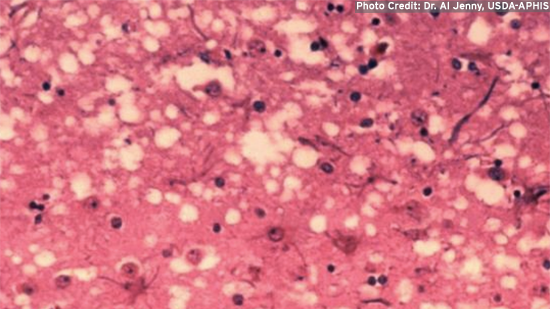
BSE (Mad Cow)
What is BSE (Mad Cow)?
Bovine Spongiform Encephalopathy (BSE) or Mad Cow Disease is a “transmissible, neurodegenerative, fatal brain disease of cattle.” First diagnosed in the United Kingdom in 1986, investigations suggest that bovine brain and spinal cord which was contaminated by the BSE agent (called a prion) may have been used as ingredients in cattle feed. It is not definitively known how the agent may have appeared, but researchers think that the infection may have occurred spontaneously in cattle or possibly entered the cattle food supply from carcasses of sheep with a similar disease called scrapie (Centres for Disease Control, 2002).
WHAT ARE THE SYMPTOMS AND HOW IS IT TRANSMITTED?
In cattle, BSE affects the brain and spinal cord, causing spongy defects that are visible with a microscope. Affected animals will also have various neurological symptoms.
Transmission in animals occurs from the consumption of feed made from infected bovine materials.
HOW IS BSE CONTROLLED?
The primary control of BSE is via the source of supply. Food processing generally does not destroy the infective agent, since it is highly stable and resists freezing, drying and heating at normal cooking temperatures, even those used for pasteurization and sterilization. Therefore, control measures focus on destroying contaminated cattle and their offspring and using only non-infective tissues of healthy animals. Meat, mammary tissue, skin, hair, blood, serum, heart and kidney have no detected infectivity. No scientific evidence links BSE to milk.
The Harvard Centre for Risk Assessment study of various scenarios involving BSE in the United States concluded that the FDA ruminant feed rule (described below) provides a major defence against this disease.
BACKGROUND
In 1988, the United Kingdom banned the use of ruminant proteins in the preparation of animal feed (“ruminant” refers to any hoofed, even-toed, usually horned mammals of the suborder Ruminantia, such as cattle, sheep, goats and deer). In 1989, use of bovine offal (waste or by-product) that might pose a potential risk to humans in the food chain was also banned in the United Kingdom. As new research became available over the next few years, the list of banned bovine offal was revised. In 1994, the European Union banned the feeding of mammalian meat and bone meal to ruminants, but the actual implementation of these bans and their verification vary among countries. In 2001, a total feed ban was put in place because of the continued risk. Monitoring of cattle for BSE continues, and although occasional cases are reported, the overall incidence in cattle is decreasing. None of the cattle that have tested positive entered the food chain.
There are rigorous U.S. limits on importation of live ruminants (cattle, sheep and goats) and ruminant products from countries where BSE was identified, which were later extended to all European countries. After reviewing the evidence from the United Kingdom that feed contaminated with ruminant tissue was a suspected factor in the BSE outbreak and that this could lead to possible transmission of BSE to humans, the U.S. Food and Drug Administration implemented a similar ruminant feed ban that became fully effective in October 1997.
VARIANT CJD DISEASE IN HUMANS
Creutzfeldt - Jakob disease (CJD) is a fatal human disease similar to BSE. A low level of CJD occurs throughout the world, and the incidence of CJD in the United Kingdom is similar to that in other countries. However, between 1994 and 1996, ten unusual cases (variant Creutzfeldt - Jakob disease, vCJD) occurred in younger persons with no common risk factors. Like BSE, vCJD is caused by a prion, and it is suspected that consumption of contaminated beef tissue may cause vCJD. The incubation time for vCJD is likely many years to decades, so new human vCJD cases may periodically be observed. In humans, vCJD causes neurological abnormalities and is always fatal.
For assistance with this topic or other food safety questions for your operation, please Contact Us.
REFERENCES AND FURTHER INFORMATION


